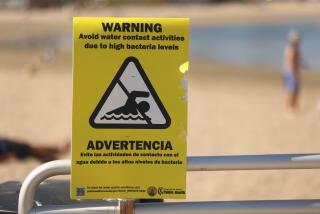Sewage Forced Closure of 2,000 U.S. Beaches in ‘91, Group Says : Environment: California led the nation with 745 closings, 588 of them in the Southland. Activists call for uniform standards for testing coastal waters.
More than 2,000 beaches were closed along the U.S. coastline last year when raw sewage threatened human health, and nearly 40% of the closures were in California, a nationwide environmental group said Thursday.
Of the 22 coastal states surveyed, 14 reported beach closures. California, with 745 beach closings, had the most in the nation. Of those, 588 were in Los Angeles, Orange and San Diego counties.
Beach-goers were probably at far greater risk than the numbers indicate because 10 states as well as some California counties do not regularly test waters for contamination.
“Warning is really imperative,” said Ann Notthoff of the Natural Resources Defense Council, which conducted the survey. “People have a right to know what risk they’re taking when swimming at the beach. Any stomachache you get from going to the beach ought to be from eating too many french fries, not from the last wave you caught,” she told a Santa Monica news conference.
Swimming in even marginally polluted waters can cause illness, the environmental group said. Gastroenteritis is the most common swimming-associated illness, with symptoms typically including vomiting, diarrhea, stomachache and sometimes fever. Eye, ear, sinus and wound infections also are common. Children are particularly susceptible.
Pollution sources include sewer overflows from overburdened or antiquated sewage treatment systems, inadequate sewage treatment and contaminated water runoff from industrial sites, streets and farms during storms.
It was the second year that the Natural Resources Defense Council has released such a report. In announcing the latest findings, the group renewed its call for uniform nationwide standards for testing coastal waters and closing beaches.
“Inconsistent polices among states mean that Americans can’t be confident they’re swimming in safe water,” Notthoff said.
Among the states that do not regularly monitor ocean pollution are Alabama, Georgia, Louisiana, Mississippi, New Hampshire, North Carolina, Oregon, South Carolina, Texas and Washington.
Seven of 17 California coastal or bay counties do not monitor on a regular basis, including Santa Barbara County, the group said. The rest are in Northern California--the counties of Marin, Contra Costa, Sonoma, Mendocino, Humboldt and Del Norte. Alameda County monitors only once a month and San Mateo County only tests the waters when volunteers are available, the report said.
The high number of beach closures in Southern California does not necessarily mean that the region’s coastal waters are more contaminated than other areas. The environmental group said water monitoring by Southern California counties generally ranks among the best in the nation.
Los Angeles and Orange counties monitor coastal waters each week. At the urging of environmental groups led by Heal the Bay and American Oceans Campaign, Los Angeles County supervisors last February adopted a detailed water monitoring program and plan for warning beach-goers of contamination.
San Diego County--which suffered a major sewage spill last February when a sewage pipe ruptured off Point Loma--monitors five times a year at beach and bay stations, and weekly near the Mexican border, the environmental group said. It reported that Ventura County monitors only after a complaint or a known sewage spill.
In a related development, Environment Now, a private group based in Malibu, reported Thursday that cholera bacteria had been found in a water sample taken from Latigo Beach about 30 yards from Latigo Creek on July 10. Jeff Harris, a doctor speaking for the group, said the finding “definitely alarmed and startled” him. He said it was “theoretically possible” to contract cholera from swimming.
But Harris’ report was greeted cautiously by the Natural Resources Defense Council and Heal the Bay, which warned against overreacting. Mark Gold of Heal the Bay said: “You don’t catch cholera from swimming in the water.”
Typically, the bacteria--found in fecal contaminated water and food, is transmitted by eating raw shellfish. Harris conceded that there have been no known cases of swimmers contracting the disease. But Gold and Joel Reynolds, a Natural Resources Defense Council attorney, agreed that it would be prudent to further test the water.
Testing the Waters
There were more than 2,000 closures of beaches along U.S. coastal states in 1991 because of the threat to human health, primarily from discharges of raw human sewage.
Of the total, 588 were along the Southern California coast from Los Angeles to San Diego.
The statistics were compiled by the Natural Resources Defense Council, an environmental group, to put pressure on Congress to approve uniform nationwide standards for testing coastal waters and closing beaches. Monitoring States (1991 Closures) California: 745 New York: 314 Florida: 299 Connecticut: 293 New Jersey: 108 Hawaii: 106 Massachusetts: 59 Maine: 47 Maryland: 24 Delare: 11 Virgina: 2 Rhode Island: 0
Coastal States that do not regularly monitor Alabama Oregon Georgia South Carolina Louisiana Texas Mississippi Washington New Hampshire North Carolina
SOURCE: Natural Resources Defense Council
More to Read
Sign up for Essential California
The most important California stories and recommendations in your inbox every morning.
You may occasionally receive promotional content from the Los Angeles Times.










